stop start Citroen DS5 HYBRID4 RHD 2014 1.G User Guide
[x] Cancel search | Manufacturer: CITROEN, Model Year: 2014, Model line: DS5 HYBRID4 RHD, Model: Citroen DS5 HYBRID4 RHD 2014 1.GPages: 382, PDF Size: 14.52 MB
Page 36 of 382
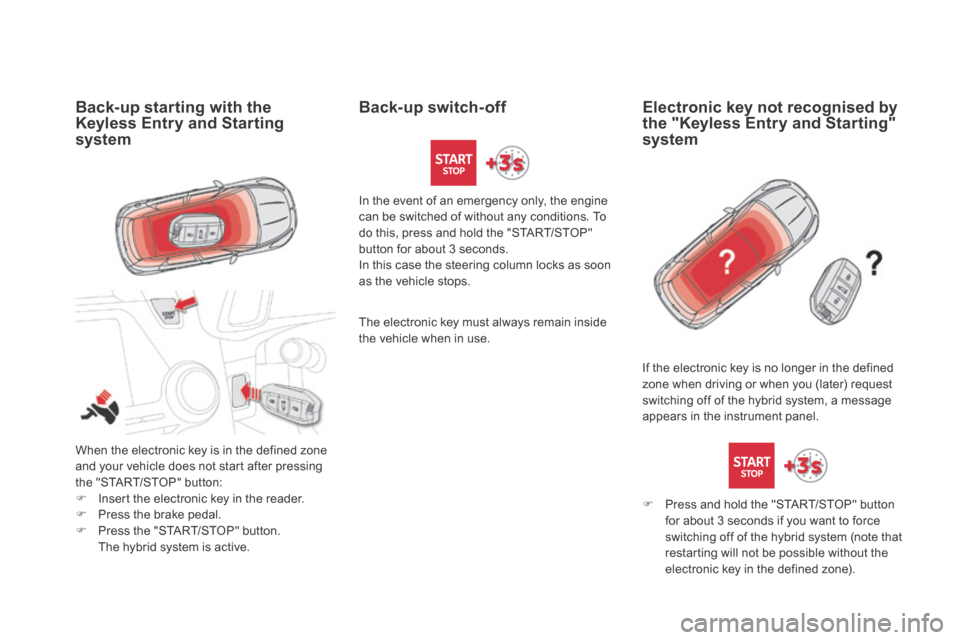
Back-up starting with the Keyless Entry and Starting system
When the electronic key is in the defined zone and your vehicle does not start after pressing the "START/STOP" button: Insert the electronic key in the reader. Press the brake pedal. Press the "START/STOP" button. The hybrid system is active.
Back-up switch-off
In the event of an emergency only, the engine can be switched of without any conditions. To
do this, press and hold the "START/STOP" button for about 3 seconds. In this case the steering column locks as soon as the vehicle stops.
Electronic key not recognised by the "Keyless Entry and Starting" system
If the electronic key is no longer in the defined zone when driving or when you (later) request switching off of the hybrid system, a message appears in the instrument panel.
Press and hold the "START/STOP" button for about 3 seconds if you want to force
switching off of the hybrid system (note that restarting will not be possible without the electronic key in the defined zone).
The electronic key must always remain inside the vehicle when in use.
Page 37 of 382
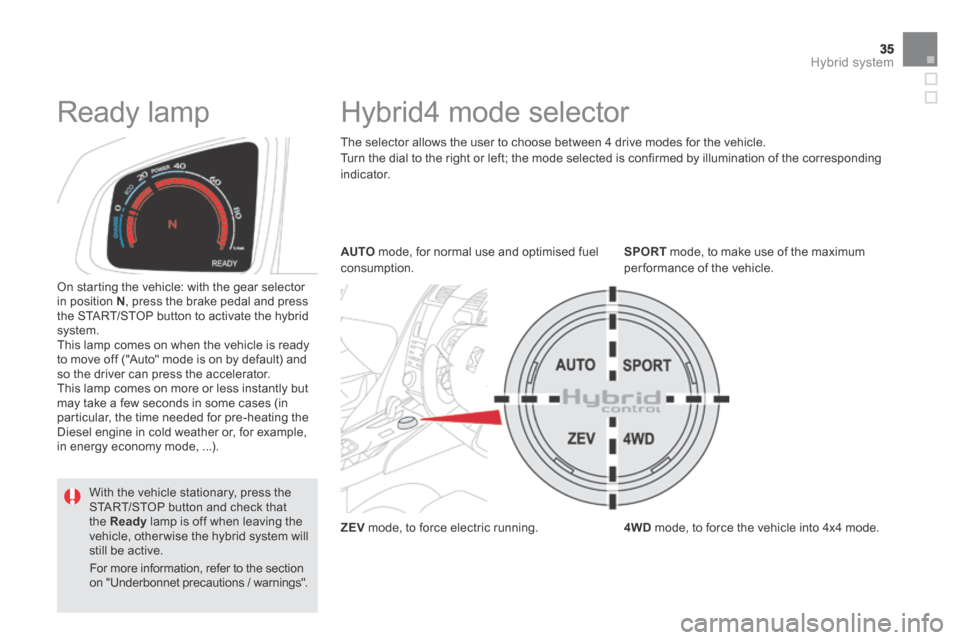
35Hybrid system
Hybrid4 mode selector
The selector allows the user to choose between 4 drive modes for the vehicle. Turn the dial to the right or left; the mode selected is confirmed by illumination of the corresponding i n d i c a t o r.
ZEV mode, to force electric running.
SPORT mode, to make use of the maximum per formance of the vehicle.
4WD mode, to force the vehicle into 4x4 mode.
AUTO mode, for normal use and optimised fuel consumption.
On starting the vehicle: with the gear selector in position N , press the brake pedal and press the START/STOP button to activate the hybrid system. This lamp comes on when the vehicle is ready to move off ("Auto" mode is on by default) and so the driver can press the accelerator. This lamp comes on more or less instantly but may take a few seconds in some cases (in particular, the time needed for pre-heating the Diesel engine in cold weather or, for example, in energy economy mode, ...).
Ready lamp
With the vehicle stationary, press the START/STOP button and check that the Ready lamp is off when leaving the vehicle, other wise the hybrid system will still be active.
For more information, refer to the section on "Underbonnet precautions / warnings".
Page 43 of 382

41Hybrid system
Examples of displays
On starting and when stationary
There is no flow of energy (the Stop & Start system stops and restarts the Diesel engine automatically).
Energy recovery
During this phase (deceleration, braking, foot off the accelerator, … all modes), the battery is recharged by the electric motor/generator, then being driven by the rear wheels. You can maximise this energy recovery by taking your foot off the accelerator pedal, deceleration will then be less marked than with a conventional vehicle.
100% electric
In all electric running (AUTO or ZEV modes), only the electric motor, powered by the battery, drives the rear wheels. The display of "Zero Emission" indicates that the Diesel engine is off and the vehicle is producing no CO2.
Page 46 of 382
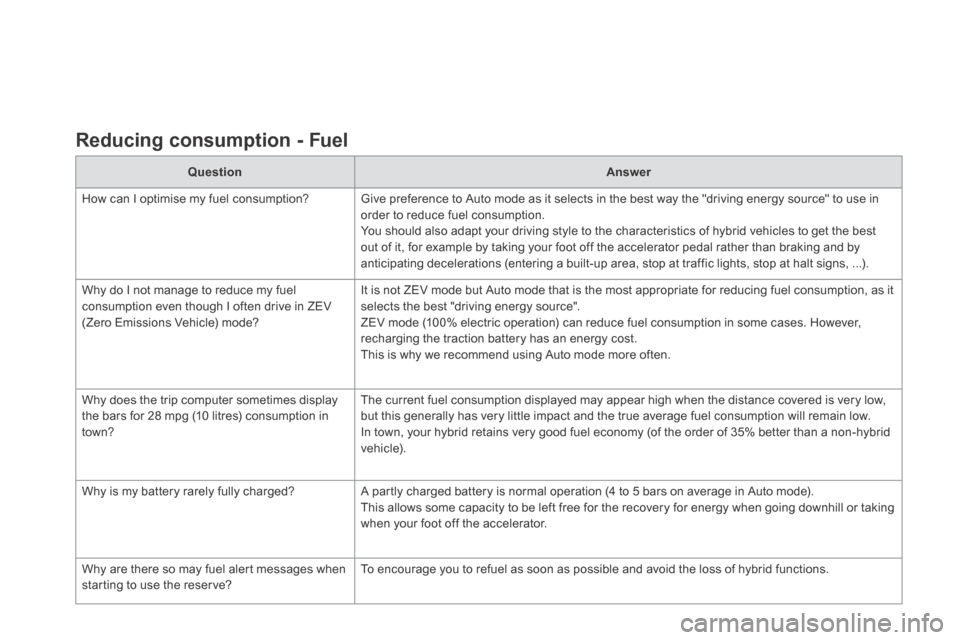
Reducing consumption - Fuel
QuestionAnswer
How can I optimise my fuel consumption? Give preference to Auto mode as it selects in the best way the "driving energy source" to use in order to reduce fuel consumption. You should also adapt your driving style to the characteristics of hybrid vehicles to get the best out of it, for example by taking your foot off the accelerator pedal rather than braking and by anticipating decelerations (entering a built-up area, stop at traffic lights, stop at halt signs, ...).
Why do I not manage to reduce my fuel consumption even though I often drive in ZEV (Zero Emissions Vehicle) mode?
It is not ZEV mode but Auto mode that is the most appropriate for reducing fuel consumption, as it selects the best "driving energy source". ZEV mode (100% electric operation) can reduce fuel consumption in some cases. However, recharging the traction battery has an energy cost. This is why we recommend using Auto mode more often.
Why does the trip computer sometimes display the bars for 28 mpg (10 litres) consumption in
town?
The current fuel consumption displayed may appear high when the distance covered is very low, but this generally has very little impact and the true average fuel consumption will remain low.
In town, your hybrid retains very good fuel economy (of the order of 35% better than a non-hybrid vehicle).
Why is my battery rarely fully charged? A partly charged battery is normal operation (4 to 5 bars on average in Auto mode). This allows some capacity to be left free for the recovery for energy when going downhill or taking when your foot off the accelerator.
Why are there so may fuel alert messages when starting to use the reserve? To encourage you to refuel as soon as possible and avoid the loss of hybrid functions.
Page 47 of 382
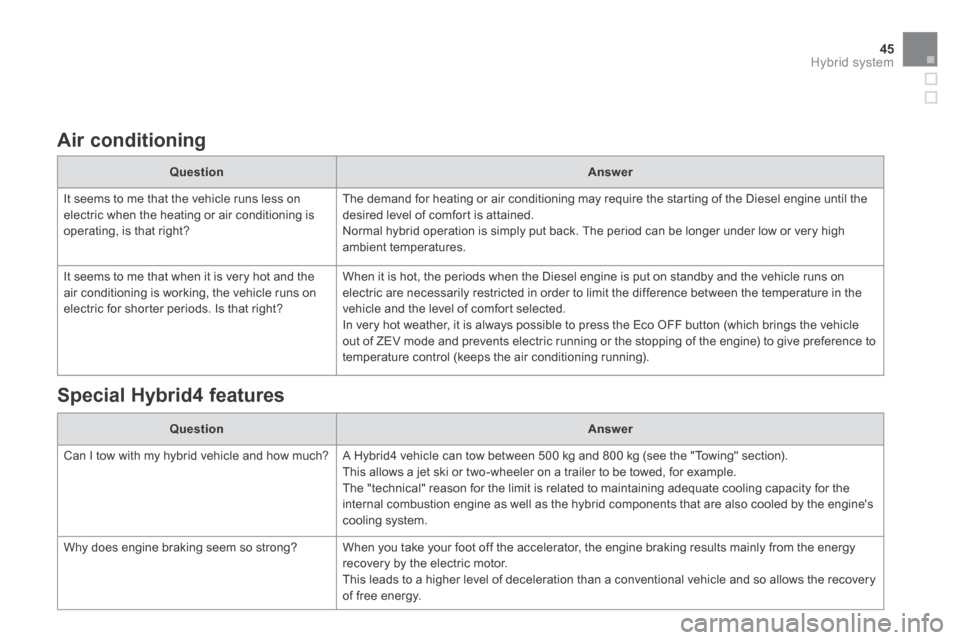
45Hybrid system
Air conditioning
QuestionAnswer
It seems to me that the vehicle runs less on electric when the heating or air conditioning is operating, is that right?
The demand for heating or air conditioning may require the starting of the Diesel engine until the desired level of comfort is attained. Normal hybrid operation is simply put back. The period can be longer under low or very high ambient temperatures.
It seems to me that when it is very hot and the air conditioning is working, the vehicle runs on electric for shorter periods. Is that right?
When it is hot, the periods when the Diesel engine is put on standby and the vehicle runs on electric are necessarily restricted in order to limit the difference between the temperature in the vehicle and the level of comfort selected. In very hot weather, it is always possible to press the Eco OFF button (which brings the vehicle out of ZEV mode and prevents electric running or the stopping of the engine) to give preference to temperature control (keeps the air conditioning running).
Special Hybrid4 features
QuestionAnswer
Can I tow with my hybrid vehicle and how much? A Hybrid4 vehicle can tow between 500 kg and 800 kg (see the "Towing" section). This allows a jet ski or two-wheeler on a trailer to be towed, for example. The "technical" reason for the limit is related to maintaining adequate cooling capacity for the internal combustion engine as well as the hybrid components that are also cooled by the engine's cooling system.
Why does engine braking seem so strong? When you take your foot off the accelerator, the engine braking results mainly from the energy recovery by the electric motor. This leads to a higher level of deceleration than a conventional vehicle and so allows the recovery of free energy.
Page 48 of 382

ECO OFF switch
This function prevents the Diesel engine being switched off and so ensures that a comfortable temperature can be maintained in the passenger compartment (air conditioning running continuously). On pressing the switch, the engine restarts
immediately. To return to normal operation, press the switch again. After switching off the ignition, the vehicle will return to normal operation (lamp in the switch off).
* Except in ZEV mode, which favours electric
running over assuring a comfortable temperature.
During electric running and when the engine is stopped, the hybrid system manages restarting automatically to assure comfort levels in the passenger compartment * . However, variations in temperature may still be felt in very hot climates. To avoid any discomfort in these conditions you can operate the ECO OFF switch.
Page 52 of 382
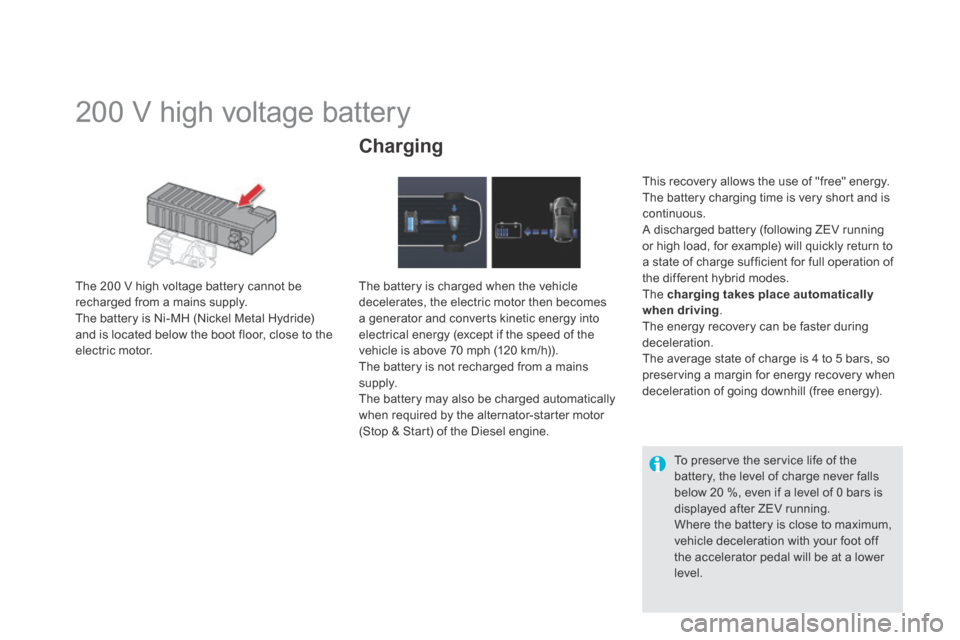
200 V high voltage battery
The 200 V high voltage battery cannot be recharged from a mains supply. The battery is Ni-MH (Nickel Metal Hydride) and is located below the boot floor, close to the electric motor.
Charging
The battery is charged when the vehicle decelerates, the electric motor then becomes a generator and converts kinetic energy into electrical energy (except if the speed of the vehicle is above 70 mph (120 km/h)). The battery is not recharged from a mains supply. The battery may also be charged automatically when required by the alternator-starter motor (Stop & Start) of the Diesel engine.
This recovery allows the use of "free" energy. The battery charging time is very short and is continuous. A discharged battery (following ZEV running or high load, for example) will quickly return to a state of charge sufficient for full operation of the different hybrid modes. The charging takes place automatically when driving . The energy recovery can be faster during deceleration. The average state of charge is 4 to 5 bars, so preserving a margin for energy recovery when deceleration of going downhill (free energy).
To preserve the service life of the battery, the level of charge never falls below 20 %, even if a level of 0 bars is displayed after ZEV running. Where the battery is close to maximum, vehicle deceleration with your foot off the accelerator pedal will be at a lower level.
Page 56 of 382
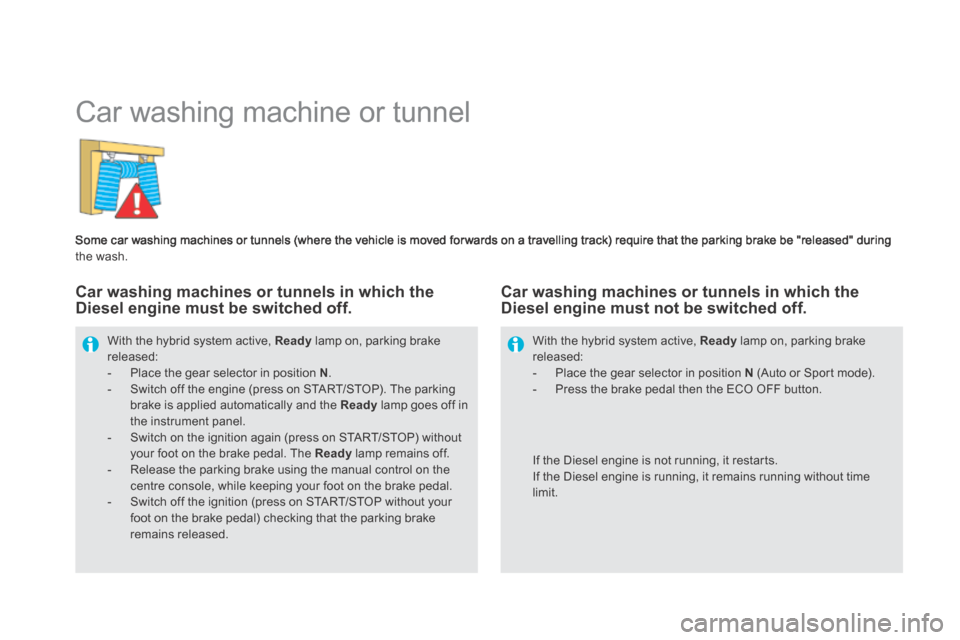
Car washing machine or tunnel
Some car washing machines or tunnels (where the vehicle is moved for wards on a travelling track) require that the parking brake be "released" during the wash.
With the hybrid system active, Ready lamp on, parking brake released: - Place the gear selector in position N . - Switch off the engine (press on START/STOP). The parking brake is applied automatically and the Ready lamp goes off in the instrument panel. - Switch on the ignition again (press on START/STOP) without your foot on the brake pedal. The Ready lamp remains off. - Release the parking brake using the manual control on the centre console, while keeping your foot on the brake pedal. - Switch off the ignition (press on START/STOP without your foot on the brake pedal) checking that the parking brake
remains released.
If the Diesel engine is not running, it restarts. If the Diesel engine is running, it remains running without time limit.
With the hybrid system active, Ready lamp on, parking brake released: - Place the gear selector in position N (Auto or Sport mode). - Press the brake pedal then the ECO OFF button.
Car washing machines or tunnels in which the Diesel engine must be switched off. Car washing machines or tunnels in which the Diesel engine must not be switched off.
Page 63 of 382
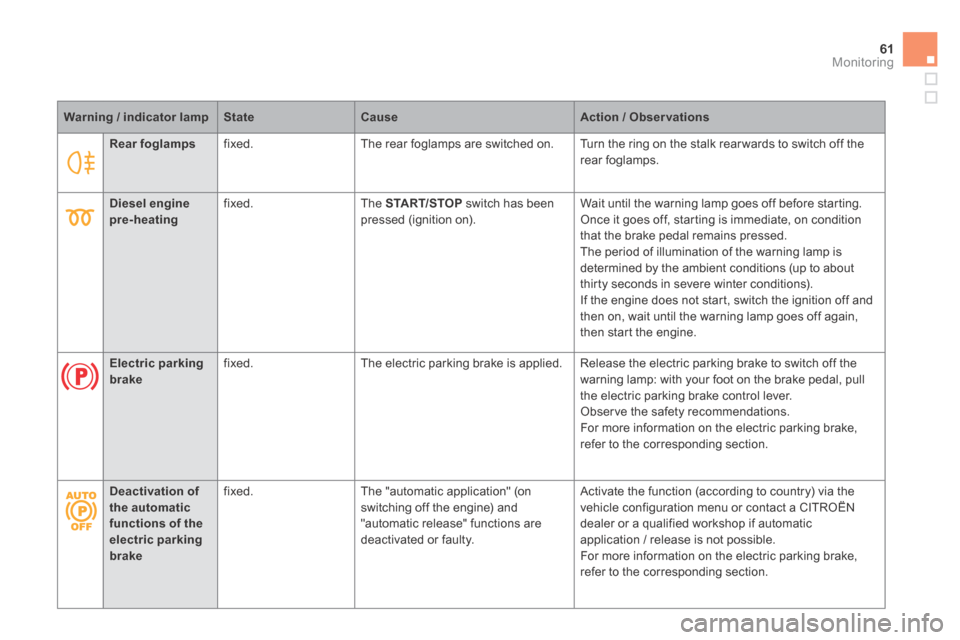
61Monitoring
Rear foglamps fixed. The rear foglamps are switched on. Turn the ring on the stalk rear wards to switch off the rear foglamps.
Warning / indicator lampStateCauseAction / Observations
Diesel engine pre-heating fixed. The START/STOP switch has been pressed (ignition on). Wait until the warning lamp goes off before starting. Once it goes off, starting is immediate, on condition that the brake pedal remains pressed. The period of illumination of the warning lamp is determined by the ambient conditions (up to about thirty seconds in severe winter conditions). If the engine does not start, switch the ignition off and then on, wait until the warning lamp goes off again, then start the engine.
Electric parking brake fixed. The electric parking brake is applied. Release the electric parking brake to switch off the warning lamp: with your foot on the brake pedal, pull the electric parking brake control lever. Observe the safety recommendations. For more information on the electric parking brake, refer to the corresponding section.
Deactivation of the automatic functions of the electric parking brake
fixed. The "automatic application" (on switching off the engine) and "automatic release" functions are deactivated or faulty.
Activate the function (according to country) via the vehicle configuration menu or contact a CITROËN dealer or a qualified workshop if automatic application / release is not possible. For more information on the electric parking brake, refer to the corresponding section.
Page 69 of 382
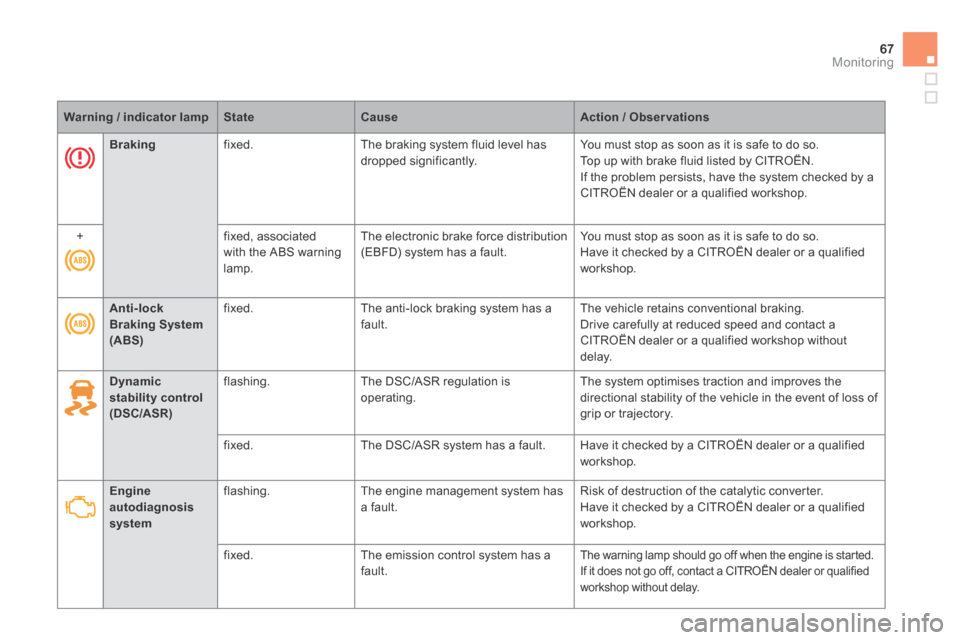
67Monitoring
Warning / indicator lampStateCauseAction / Observations
Dynamic stability control (DSC/ASR)
flashing. The DSC/ASR regulation is operating. The system optimises traction and improves the directional stability of the vehicle in the event of loss of grip or trajectory.
fixed. The DSC/ASR system has a fault. Have it checked by a CITROËN dealer or a qualified workshop.
Engine autodiagnosis system
flashing. The engine management system has a fault. Risk of destruction of the catalytic converter. Have it checked by a CITROËN dealer or a qualified workshop.
fixed. The emission control system has a fault. The warning lamp should go off when the engine is started. If it does not go off, contact a CITROËN dealer or qualified
workshop without delay.
Anti-lock Braking System (ABS)
fixed. The anti-lock braking system has a fault. The vehicle retains conventional braking. Drive carefully at reduced speed and contact a CITROËN dealer or a qualified workshop without d e l ay.
Braking fixed. The braking system fluid level has dropped significantly. You must stop as soon as it is safe to do so. Top up with brake fluid listed by CITROËN. If the problem persists, have the system checked by a CITROËN dealer or a qualified workshop.
+ fixed, associated with the ABS warning lamp.
The electronic brake force distribution (EBFD) system has a fault. You must stop as soon as it is safe to do so. Have it checked by a CITROËN dealer or a qualified workshop.